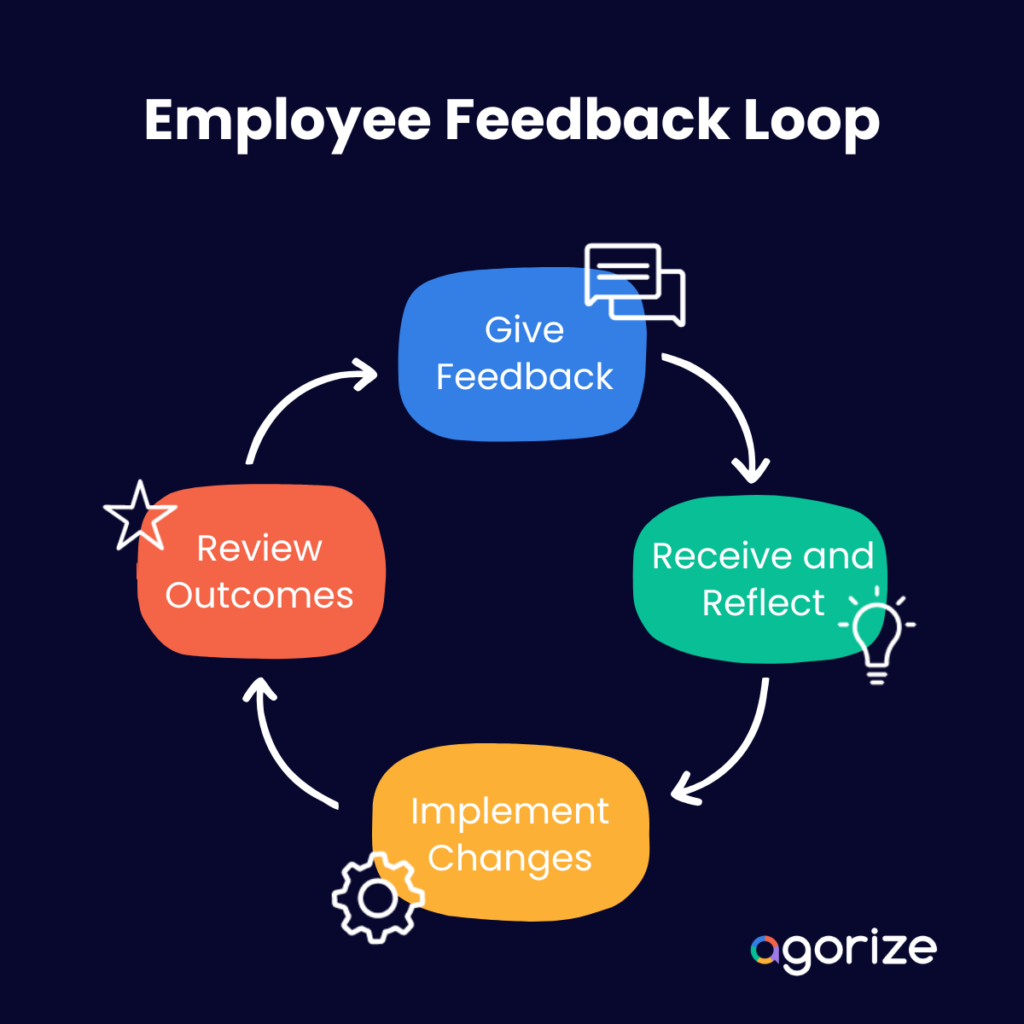This article is written by Jeremy Chatelaine.
Building a culture where feedback thrives isn’t just beneficial; it’s like adding rocket fuel to your company’s growth engine. Through feedback, you get a direct line to the brilliant ideas and honest opinions of your team members.
But, getting there isn’t as simple as declaring an open-door policy. It’s about crafting an environment where feedback is celebrated. Every piece of advice becomes a building block for something bigger.
So, how do you turn this treasure trove of insights into actionable change? And more importantly, why should you bother?
Let’s dive into the magic of a continuous feedback framework that can boost motivation, ramp up engagement, and steer your company toward success.
Understanding the power of employee feedback
Receiving open and honest feedback from employees enables companies to understand strengths and areas for improvement at both an organizational and individual level. Feedback is important whether you have an entrepreneurial startup or a mature corporation. 68% of respondents in a McKinsey survey say ongoing coaching and developmental feedback positively affect an individual’s performance. But only 14.5% of managers strongly agree that they are effective at giving feedback.
Implementing regular employee surveys, for example, provides insights into how staff view policies, leadership, work culture, facilities, and other aspects that impact performance and satisfaction. Analyzing this feedback helps identify what works well to continue those practices and what needs to change to better support employees.
Specifically, employee surveys and other feedback channels like focus groups, interviews, or suggestion boxes give voice to employee perspectives. This allows you to gather constructive criticism and negative feedback in a controlled way.
Rather than letting tensions build, enabling a feedback culture surfaces problems early when they can still be addressed. Issues like inadequate training, lack of role clarity, micromanagement, poor communication, or weak teamwork can all drag down individual productivity as well as team cohesion. You don’t want to wait until you get bad reviews on Glassdoor to make changes.
By listening to employee concerns, companies can diagnose issues and intervene with targeted solutions. This prevents small problems from festering into much larger challenges down the road.
Plus, feedback enables clear communication of employee wants and needs. Understanding staff priorities for professional development, work-life balance, compensation, or growth opportunities allows companies to create talent management and retention programs that meet these desires.
Employees who feel heard by giving feedback experience greater job satisfaction. This further motivates them to develop new skills and improve their performance – especially when companies close the feedback loop by communicating how employee perspectives shape impactful changes.
How to build a feedback-friendly culture
To cultivate a culture that embraces feedback, it’s essential to prioritize psychological safety. This sets the stage for everyone to express themselves freely and with honesty. Incorporating regular feedback mechanisms like surveys, performance evaluations, and more casual methods helps gather diverse insights into the employee experience. We’ll cover a few strategies below.
Use surveys
To use surveys effectively in fostering a feedback-friendly culture at work, start by designing concise, relevant surveys that respect employees’ time.
For instance, quarterly pulse surveys with targeted questions can gauge workplace sentiment and identify improvement areas. Ensure anonymity to encourage honest feedback, making it clear that all opinions are valuable and will be used constructively.
Share results transparently with the team, highlighting positive feedback and discussing plans to address concerns. This approach demonstrates that feedback leads to action, reinforcing trust. Also, encourage managers to follow up on survey insights during one-on-one meetings, personalizing the feedback loop.
Over time, this practice builds a culture where feedback is continuously sought, shared, and acted upon, enhancing workplace communication and collaboration.
Strategize performance evaluations
Using performance evaluations to foster a feedback-friendly culture involves integrating continuous, constructive dialogue into the process. Start by setting clear, attainable goals.
For instance, a sales team could aim for a 10% increase in quarterly sales. During evaluations, highlight achievements and areas for growth, ensuring feedback is specific and actionable. If a sales team member developed a great LinkedIn lead generation strategy, highlight that and learn how the rest of the team can leverage it.
Encourage self-assessment to engage employees in their development journey. Finally, embrace a forward-looking approach by collaboratively setting future objectives, making the evaluation a stepping stone rather than a judgment day. This method transforms evaluations into a powerful tool for building a culture of open dialogue and continuous improvement.

Run focus groups
To build a feedback-friendly culture, you can also conduct regular focus groups to understand employees’ perspectives. Ask open-ended questions about communication practices, review processes, and relationships with management.
Listen without judgment. Identify themes around positive experiences, paint points, and desired changes. Develop recommendations, like monthly manager check-ins, peer reviews before formal evaluations, anonymous surveys, town halls, and opt-in feedback channels.
Implement select suggestions and continue engaging focus groups to iterate based on feedback. This conversational approach demonstrates a genuine commitment to a collaborative, growth-focused environment.
Facilitate 360 evaluations
360 evaluations, where employees receive confidential feedback from managers, peers, and direct reports, can build a feedback-friendly workplace culture.
The key is using 360s for development rather than judgment. Frame them as opportunities for growth by providing performance or sales coaching. Allowing people time to process feedback before acting prevents negative reactions.
With support instead of criticism, employees feel safe being vulnerable and can see critiques as helpful input to improve. This facilitates openness to feedback and motivates learning.
Set up idea boxes
Employee idea boxes can be a simple yet effective way to gather input. Set up locked boxes in high-traffic areas like breakrooms. Provide small slips of paper and pens for submitting anonymous ideas. Check the boxes weekly and sort submissions by topic, like improvements to equipment, policies, or workflows.
Review the suggestions in management meetings, select the most feasible and impactful, and then communicate back to staff on changes to be implemented based on their feedback. This shows employees their voices are valued while improving operations.

The role of employee feedback in improving employee recognition
Employee feedback plays a crucial role in recognizing and appreciating the efforts of employees within an organization. According to studies, 41% of employees have left their jobs because they felt they weren’t listened to.
Actively seeking input from employees about their experiences, achievements, and challenges provides valuable insights into their individual contributions and strengths. This feedback forms the basis for personalized recognition efforts, enabling managers to acknowledge employees in ways that resonate with their unique contributions.
Whether through public praise, rewards, or growth opportunities, incorporating employee feedback into recognition programs fosters a culture of appreciation and motivates sustained high performance.
When employees feel heard and valued, they are more likely to stay engaged, productive, and committed to the organization’s success. Integrating employee feedback into recognition initiatives is not just beneficial for morale but also essential for driving long-term employee satisfaction and retention.
Turning feedback into action
Company leaders should thoughtfully review employee feedback once they gather it to identify improvement areas. During annual performance reviews or constructive feedback sessions, leaders should receive feedback openly without getting defensive. They should determine what type of feedback is being given – positive or developmental – and respond appropriately.
For anonymous feedback through surveys or forms, managers and leaders should note trends in constructive criticism and create action plans to tackle the issues. If multiple people on your said your cold email software isn’t working for their needs, don’t wait until next quarter to work toward a solution.
By fostering a culture where employees feel comfortable both giving and receiving feedback, leaders create a positive work environment where employees are more likely to provide suggestions and feel their voices are heard. This not only aids in employee retention but helps the company continuously improve.
Feedback should inform training programs, updated policies and processes, recognition programs, and performance management tactics. Through thoughtful review and responsive action, leaders can transform feedback into positive change.
You can also incorporate feedback in your hiring practices. If you’re organizing a hackathon to identify new talent, for example, you can run a survey about current hiring and onboarding practices to improve your process. You have the choice to reconnect with the participants by sending cold text messages or emails.
The overall goal is to establish a loop where employees see their feedback makes an impact, making them more engaged and productive. By taking employee perspectives seriously and implementing suggested improvements, company leaders foster a culture of open communication, continual growth, and shared success.
Next steps
For organizations looking to truly excel, leveraging employee feedback is crucial. It’s more than just gathering thoughts; it’s about turning those insights into concrete actions that drive your business forward. The success of your organization is closely linked to how attentively you listen and react to what your employees are saying.
Now is the perfect moment to weave strong feedback mechanisms into your everyday activities. Foster open conversations, carry out consistent surveys, and cultivate an environment where feedback isn’t only appreciated but also acted upon.
As you navigate this path, feel free to share your stories or pose questions. Your proactive stance on feedback could serve as a model for others, encouraging a culture of ongoing progress and innovation.










